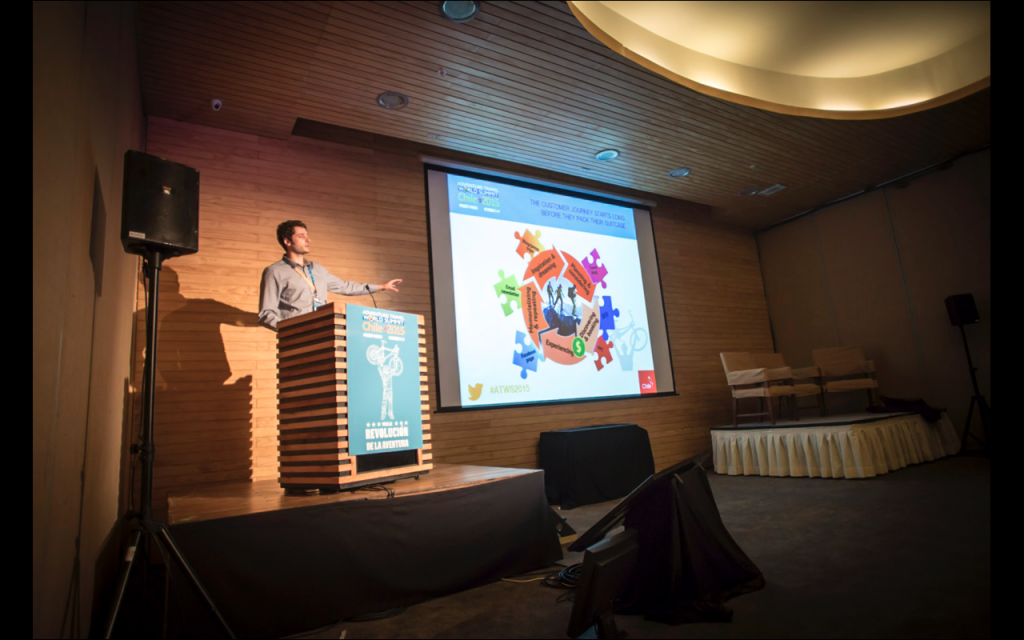by Matthew Barker, Head of Strategy, I&I Travel Media
The Peer2Peer sessions were a highlight at last year’s Adventure Travel World Summit in Puerto Varas, Chile. High on the list of talking points was the question of content marketing - what it is, how it applies to the adventure travel industry, and how companies can measure their results.

© ATTA / Lukasz Warzecha
We covered the subject in detail during my session Measuring Your Content [slides], sparking some excellent questions and much discussion in the Peer2Peer Exchange that followed.
Here are some of the Q&A highlights:
Q: How do we reach consumers with inspiring, authentic destination messages in an increasingly crowded media space where there are many voices, but few credible ones?
This question goes to the root of the problem with “content marketing.”
We are swimming against a rising tide of low grade content, churned out by people with no real expertise or authority, and then blasted out shotgun style to as many people as possible.
This is a fool’s game. The best way to beat it is by not getting involved.
Content marketing is most effective when done selectively and with restraint. Adventure travel companies, especially those with limited resources, should aim for quality interactions over quantity - a rifle, not a shotgun.
Instead of mass reach or vague ambitions of "going viral” start with your precise audience and their particular needs and then work exclusively for that narrowly defined cohort.
Ignore everyone else.
Identify where this audience is active at each stage of the customer journey and be there, providing consistent, credible value.
So what is content of value? Deirdre Campbell, President & CEO at Tartan Group, gave a few good examples:
“Practical, useful information: What does it take to get to the stunning view? Is there a local culinary or agri-food tour? Can you bike, hike or drive to adventures? Can you map your own trail and book a local guide? What is the weather like during various times of the year and are there advantages of going in low, shoulder or high season that guidebooks don’t mention? Is there a locals know section – where local ‘characters’ talk about their favourite local experiences?”
“Some clients have even posted blog posts with titles like “Is [name] resort right for me?” where they describe what type of traveler enjoys their experiences the most and which travelers have been disappointed. We believe this type of authentic, transparent information (bring rain boots in July and bug spray in August) builds trust and confidence in a destination, while still inspiring a visit.”
Curate, don’t create.
Instead of contributing to the deluge, recognise the value of curating authoritative content from other credible and reliable sources that your audience will value. (Tip: Outbounding is a good source for content curation.)
Use your expertise to build your own audience of qualified, engaged travellers - people who are actually likely to book a trip with your company. Get as many people onto your email lists and other owned channels (things you directly control - not Facebook followers.)
Treat readers and audiences with the respect they deserve and they'll value you as an island of credibility in an ocean of garbage.
An important approach is to empower your happy customers to help distribute your content and promote your brand to their own networks of friends and families. As Deirdre Campbell wrote in the P2P follow-up:
“Invest in creating outstanding customer experiences with lots of guest/local interaction and you will build ‘brand ambassadors’ who will tell your destination story for you. This is as important for destinations as it is for experiences like hotels, attractions and restaurants.”
Put yourself in their shoes.
Most importantly, as Brendan Mark, Sales and Marketing Director of Heliconia, said:
“The first thing to remember is that it’s not about you. Engage your target customers with content that elicits an emotion or a feeling, and attach your destination message to this. If you have a great biking destination then you should be telling great biking stories.”
This is an excellent point: Content marketing is about telling stories and sharing information that the traveler wants and needs to dream, research and plan a trip - not what your company wants to tell them about yourself, your brand and your products.
Q: What kind of content distribution channels are available (paid or unpaid) for a travel company?
Part of the problem with content strategy is the sheer number of channels and tools that exist for publishing, sharing and promoting your content. It can feel overwhelming, and even make you feel guilty that you’re not doing everything, or keeping up with the latest channel.
Suddenly everyone is talking about Instagram and we think “Oh crap - now we need a Instagram strategy too!”
This is the wrong perspective.
We need to be thinking from the perspective of the target audience - who they are and where they’re active. Every audience is different, relying on different sources of information for each stage of the journey to purchase.
Here are a few examples:
Top funnel / "inspiration & dreaming" stages:
- Social media - especially Facebook (and FB ads) but also Pinterest & Instagram for images.
- Twitter can be useful as an indirect channel, i.e. finding consumer influencers to promote your content to their audiences.
- Outreach & FAM trips with travel bloggers, media and other consumer influencers.
- Display advertising.
- Press and media coverage.
- SEO, especially if you have a large blog archive. If you have other assets (brochures, guides, old email archives etc) try to convert as much as possible into blog content.
- Content amplification tools such as Outbrain (your mileage may vary).
- Recapture prospects with SEO.
- Search remarketing (Adwords).
- Email can be effective, depending on quality of the offer.
- Content curation via social and email.
- Email newsletters / magazines.
Q: How much should we spend on marketing & advertising as a percentage of sales?
Jillian Dickens, Director at Bannikin, said: “Although there are a ton of different scenarios to consider, in general between 4 - 10% of annual gross revenue is a healthy percentage (10% being quite high). Another formula to consider is cost per acquisition - how much are you currently spending to gain one confirmed guest? This is very wide ranging in our industry.”
Test, review and test again.
Jonathan Burnham, Marketing Manager of Wildland Adventures, said: “You just need to experiment to find your sweet spot. I would try putting some more money into your marketing budget and go until you get the results you want. A lot of different types of advertising campaigns take a good amount of time to mature. Also, if you aren’t seeing the best results, try tweaking things before you give up. Don’t stop, just get better.”
Q: How do I get better ROI on my marketing spend?
The first step is to understand where your returns are actually coming from. Explore your Assisted Conversion reports in Google Analytics and identify which channels are assisting leads as well as sending the last-click. Be sure to configure goal tracking and goal values to get the full data.
Now look at your main traffic sources (“acquisition”). Which of these contribute most to your conversions, either assisted or last click? Which aren’t performing so well? Depending on the source of the traffic (and the nature of the visitors it’s bringing) you can identify new opportunities to “close the loop” and make sure more of those people end up coming back to the site to book.
Close the loop.
Example 1. Maybe you’re getting high-funnel social media traffic but they never come back to book? In which case look at retargeting to try and close the loop.
Example 2. Maybe you get lots of repeat visitors but last click conversion rates are low. In which case optimise your landing pages and re-evaluate how well qualified or targeted the clicks are.
ROI is about connecting the dots over the entire customer journey. Create touch points that bring them back to the site as they progress through the lifecycle, and measure the performance of each one.
In theory, calculating ROI is simple - profits minus costs. As Julie Thorner, President of Liquid Spark, wrote: “You have to know how much it costs, how many people it brings to your website, and how many people actually book a trip due to your initiative or campaign.”
“Focus your marketing on only those campaigns that meet your business objectives for selling more trips. Don’t get distracted by campaigns that you can’t measure or that spread your marketing budget too thin.”
For more on content marketing and ROI, see the slides from our ATWS session: Measuring Your Content: Turning Audiences Into Bookings.



